Abstract
There are conflicting reports on plasma insulin concentrations in the acutely injured. Plasma insulin and glucose concentrations have been measured in 504 patients within 8 h of injury, and related to the severity of injury as assessed by the injury severity score (ISS). As in previous surveys of injured patients, an extremely wide range of insulin concentrations was found (2-141 mU/l). Most of the variability occurred at lower severities of injury. In very severely injured patients (ISS greater than or equal to 30), insulin concentrations were uniformly suppressed (less than 20 mU/l), especially in relation to the hyperglycaemia in these patients. Two small subgroups, patients dying within 3 h of injury and known psychiatric patients on psycho-active drugs, differed from the general pattern in displaying elevated insulin concentrations despite very severe injuries. The results bear out the idea that insulin secretion is usually acutely suppressed by adrenaline after severe injury; after less severe injuries, however, the response is much less uniform.
Full text
PDF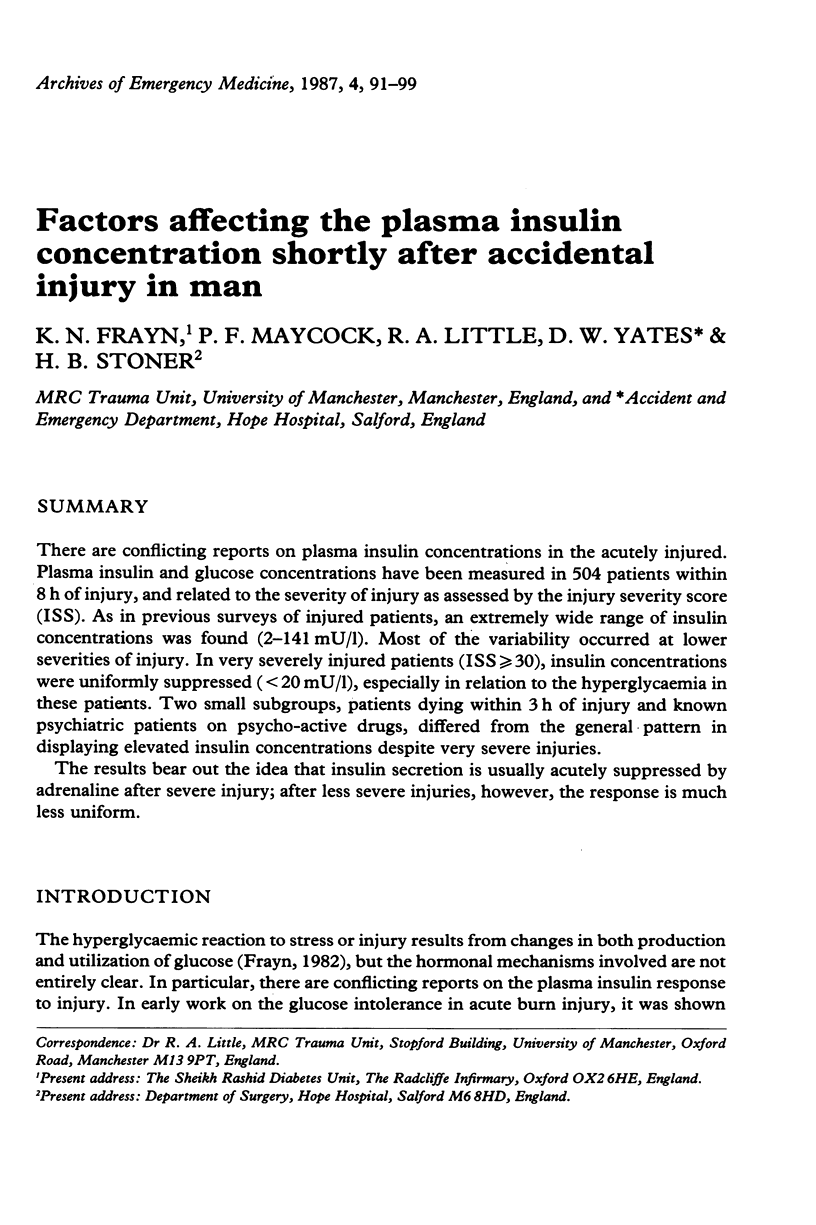
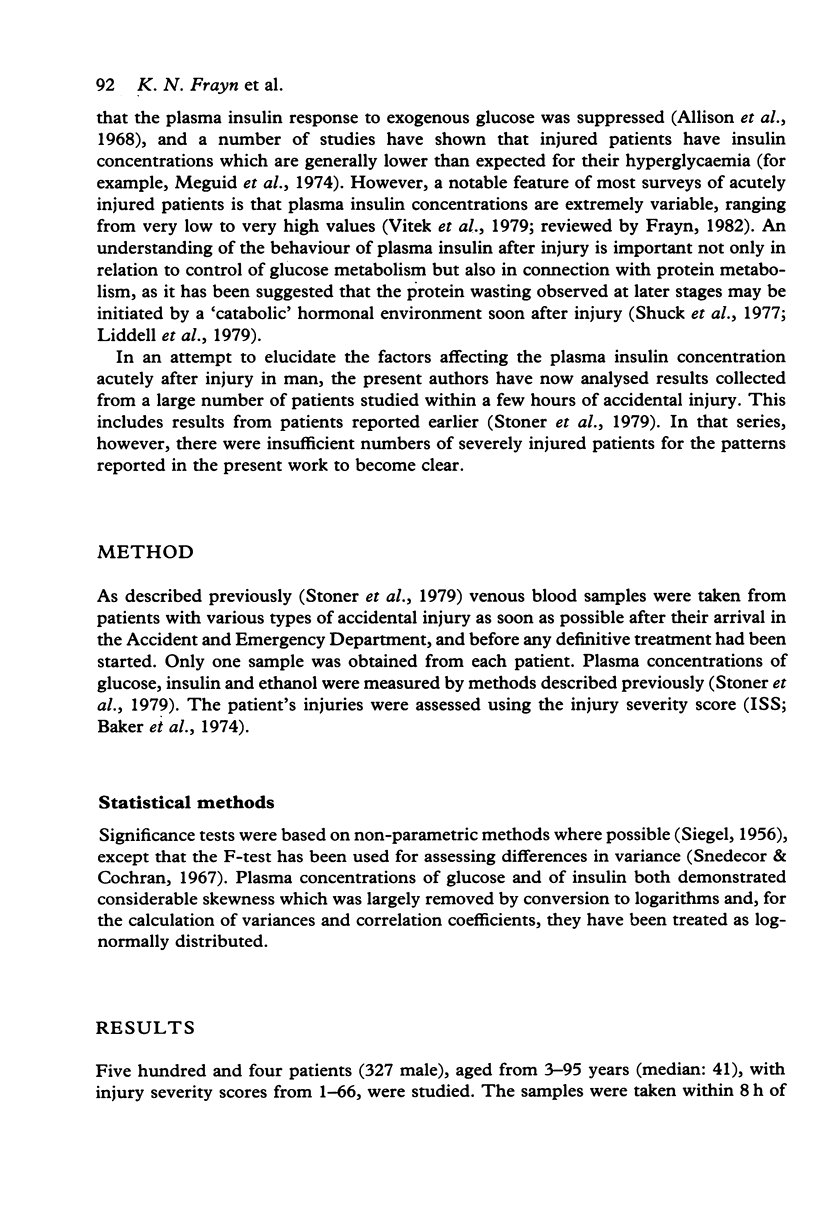
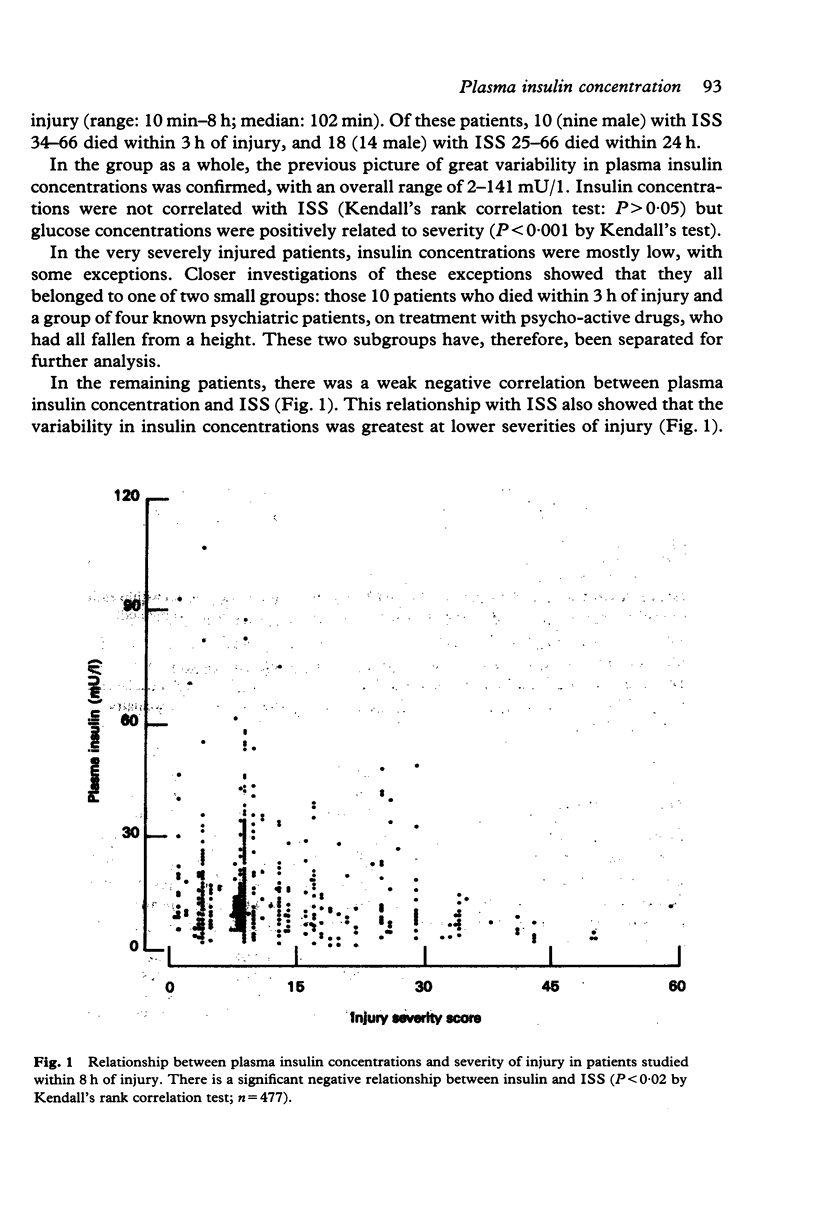

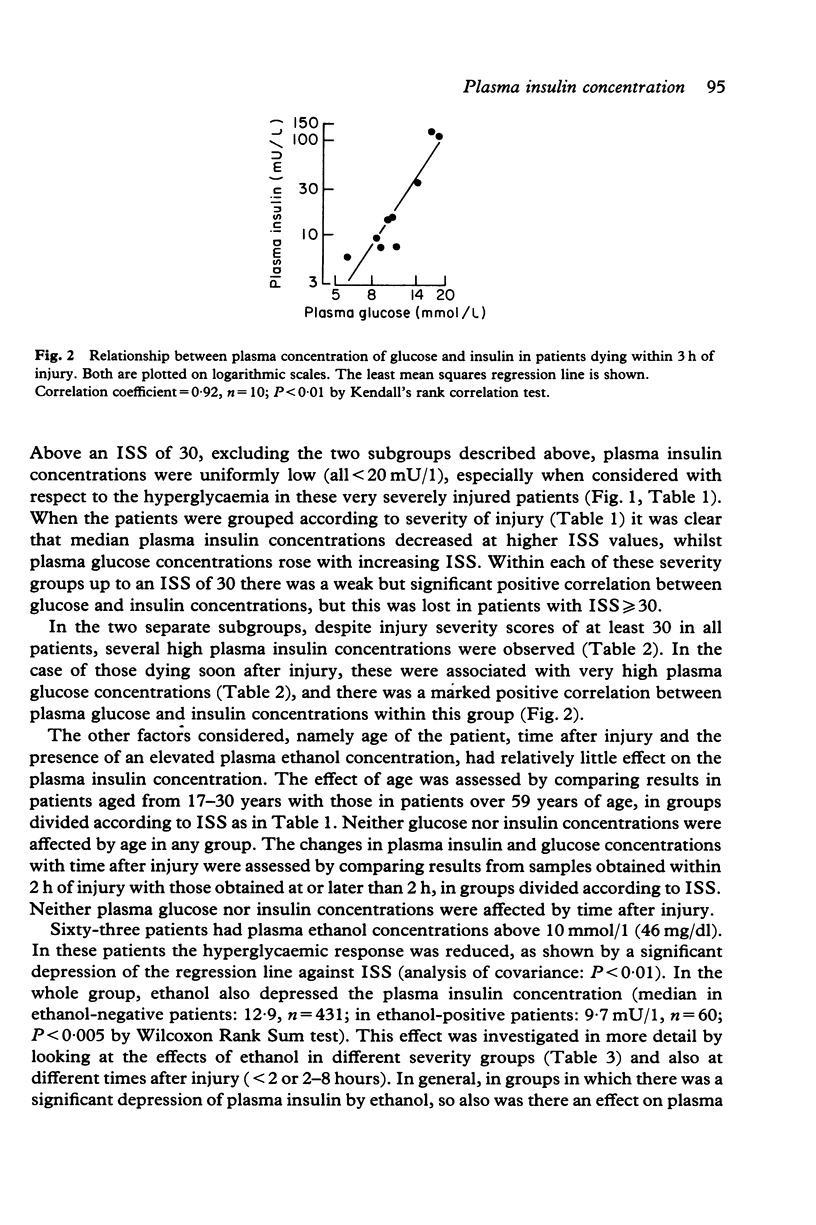
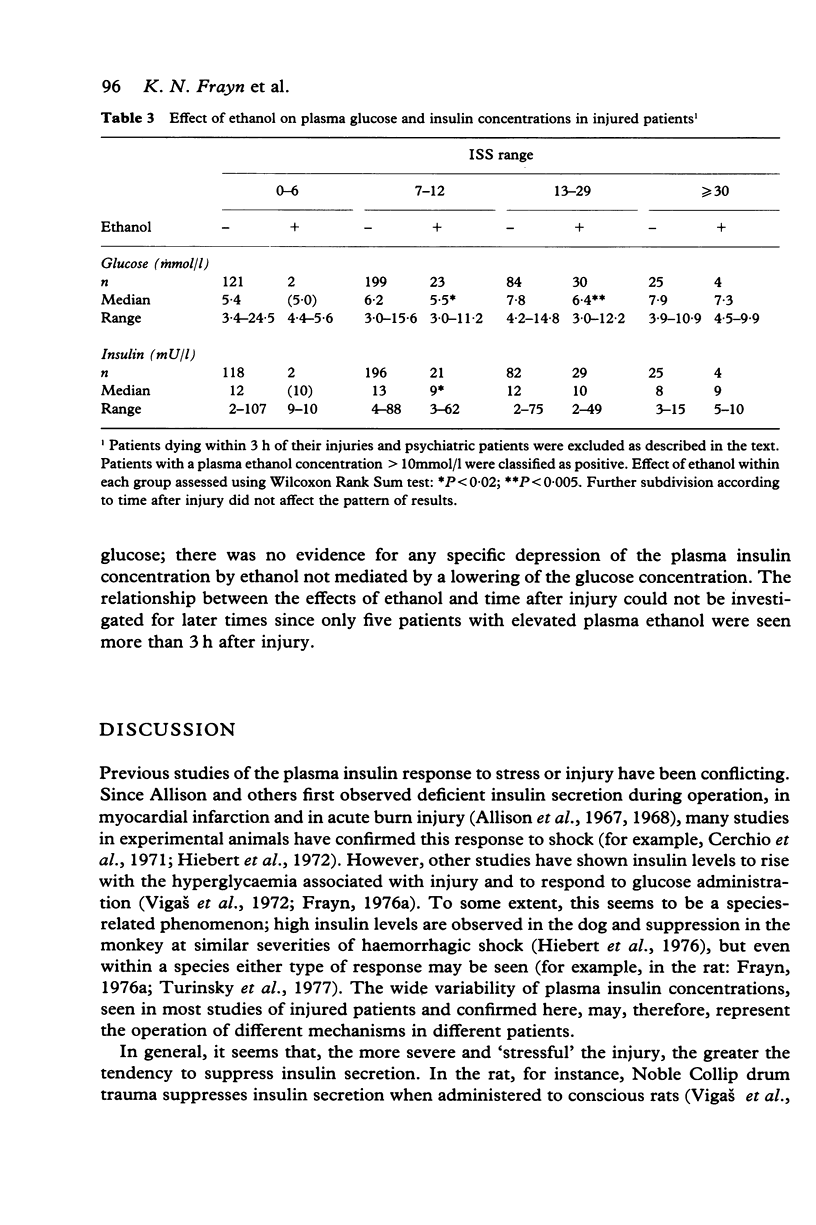
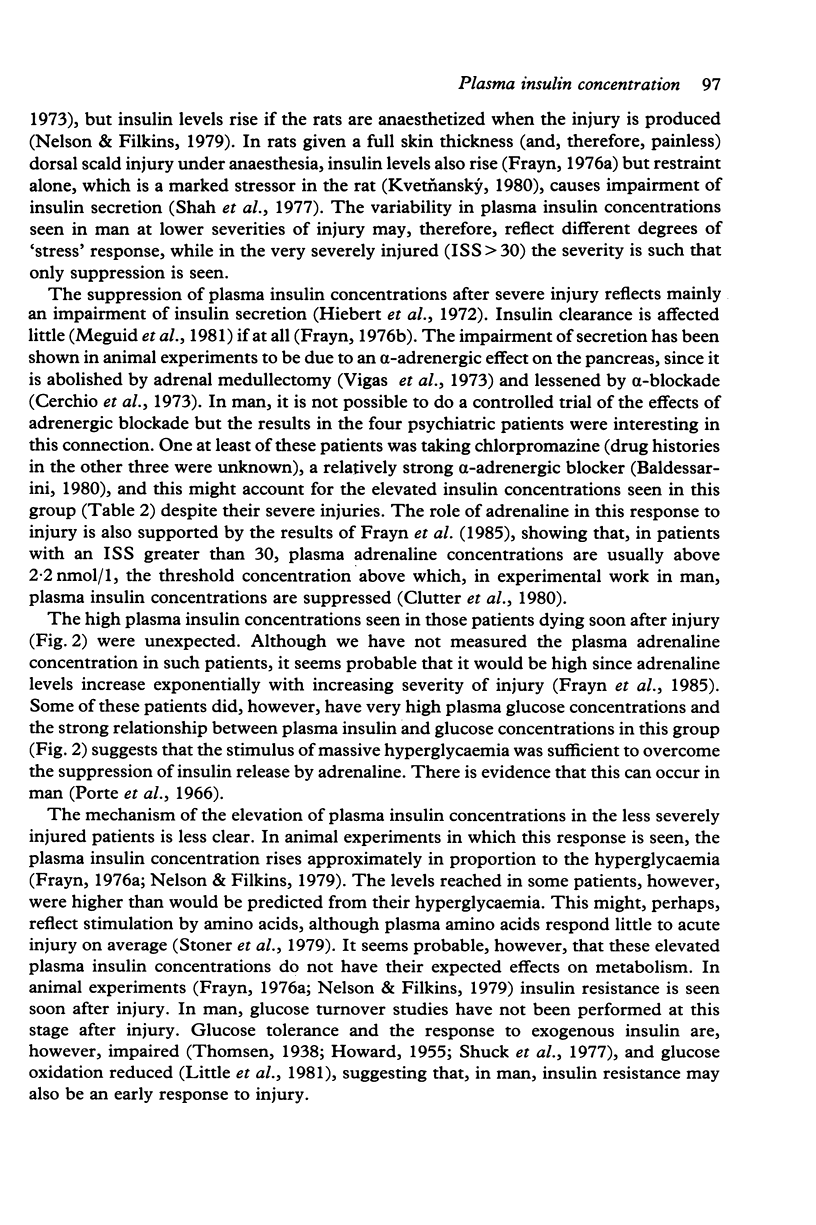
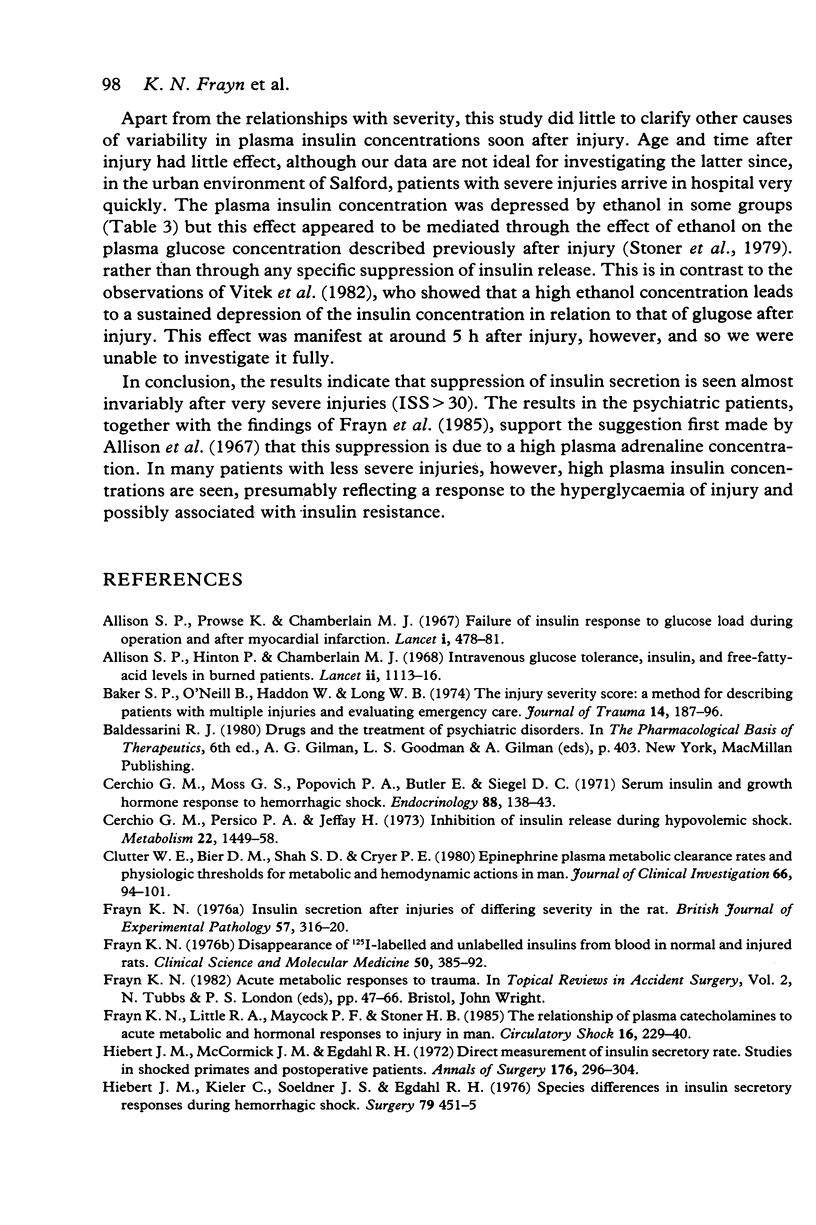
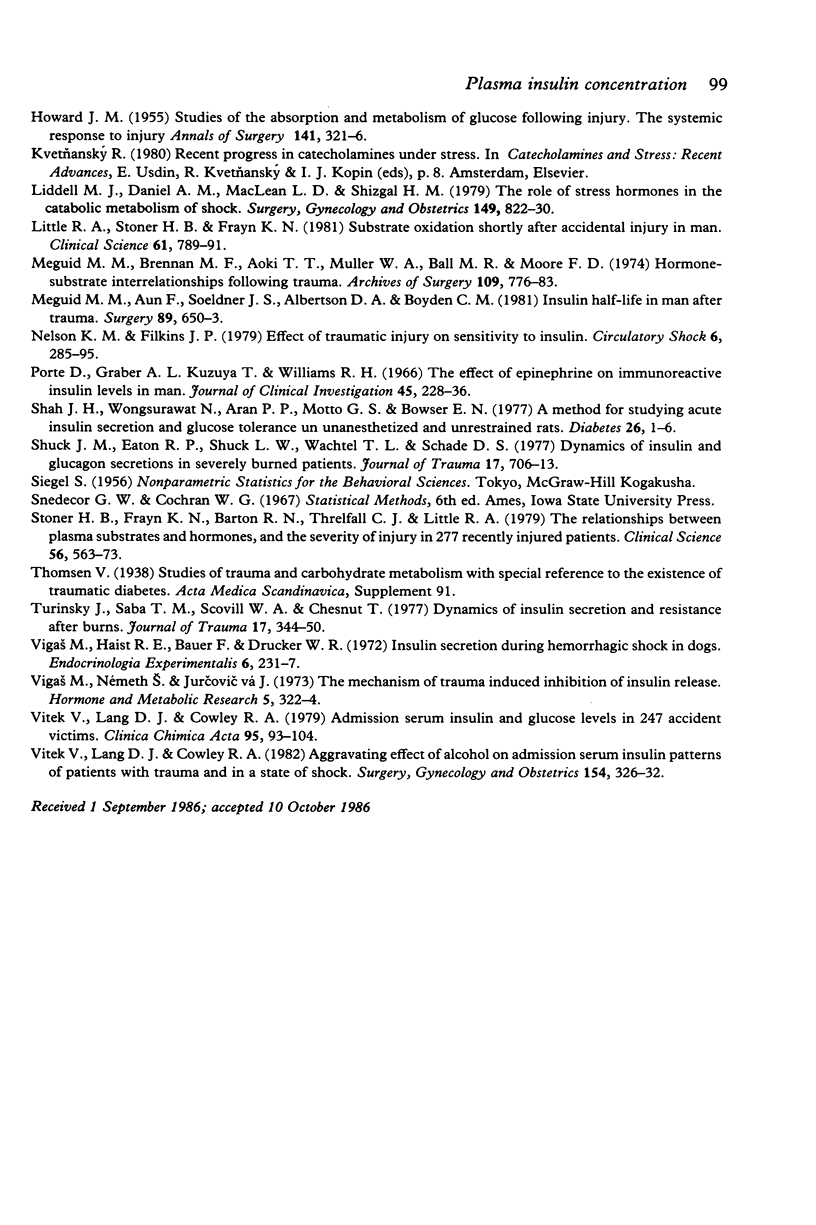
Selected References
These references are in PubMed. This may not be the complete list of references from this article.
- Allison S. P., Hinton P., Chamberlain M. J. Intravenous glucose-tolerance, insulin, and free-fatty-acid levels in burned patients. Lancet. 1968 Nov 23;2(7578):1113–1116. doi: 10.1016/s0140-6736(68)91581-x. [DOI] [PubMed] [Google Scholar]
- Allison S. P., Prowse K., Chamberlain M. J. Failure of insulin response to glucose load during operation and after myocardial infarction. Lancet. 1967 Mar 4;1(7488):478–481. doi: 10.1016/s0140-6736(67)91097-5. [DOI] [PubMed] [Google Scholar]
- Baker S. P., O'Neill B., Haddon W., Jr, Long W. B. The injury severity score: a method for describing patients with multiple injuries and evaluating emergency care. J Trauma. 1974 Mar;14(3):187–196. [PubMed] [Google Scholar]
- Cerchio G. M., Moss G. S., Popovich P. A., Butler E., Siegel D. C. Serum insulin and growth hormone response to hemorrhagic shock. Endocrinology. 1971 Jan;88(1):138–143. doi: 10.1210/endo-88-1-138. [DOI] [PubMed] [Google Scholar]
- Cerchio G. M., Persico P. A., Jeffay H. Inhibition of insulin release during hypovolemic shock. Metabolism. 1973 Dec;22(12):1449–1458. doi: 10.1016/0026-0495(73)90012-7. [DOI] [PubMed] [Google Scholar]
- Clutter W. E., Bier D. M., Shah S. D., Cryer P. E. Epinephrine plasma metabolic clearance rates and physiologic thresholds for metabolic and hemodynamic actions in man. J Clin Invest. 1980 Jul;66(1):94–101. doi: 10.1172/JCI109840. [DOI] [PMC free article] [PubMed] [Google Scholar]
- Frayn K. N. Disappearance of 125I-labelled and unlabelled insulins from blood in normal and injured rats. Clin Sci Mol Med. 1976 May;50(5):385–392. doi: 10.1042/cs0500385. [DOI] [PubMed] [Google Scholar]
- Frayn K. N. Insulin secretion after injuries of differing severity in the rat. Br J Exp Pathol. 1976 Jun;57(3):316–320. [PMC free article] [PubMed] [Google Scholar]
- Frayn K. N., Little R. A., Maycock P. F., Stoner H. B. The relationship of plasma catecholamines to acute metabolic and hormonal responses to injury in man. Circ Shock. 1985;16(3):229–240. [PubMed] [Google Scholar]
- HOWARD J. M. Studies of the absorption and metabolism of glucose following injury; the systemic response to injury. Ann Surg. 1955 Mar;141(3):321–326. doi: 10.1097/00000658-195503000-00005. [DOI] [PMC free article] [PubMed] [Google Scholar]
- Hiebert J. M., Kieler C., Soeldner J. S., Egdahl R. H. Species differences in insulin secretory responses during hemorrhagic shock. Surgery. 1976 Apr;79(4):451–455. [PubMed] [Google Scholar]
- Hiebert J. M., McCormick J. M., Egdahl R. H. Direct measurement of insulin secretory rate: studies in shocked primates and postoperative patients. Ann Surg. 1972 Sep;176(3):296–304. doi: 10.1097/00000658-197209000-00005. [DOI] [PMC free article] [PubMed] [Google Scholar]
- Liddell M. J., Daniel A. M., MacLean L. D., Shizgal H. M. The role of stress hormones in the catabolic metabolism of shock. Surg Gynecol Obstet. 1979 Dec;149(6):822–830. [PubMed] [Google Scholar]
- Little R. A., Stoner H. B., Frayn K. N. Substrate oxidation shortly after accidental injury in man. Clin Sci (Lond) 1981 Dec;61(6):789–791. doi: 10.1042/cs0610789. [DOI] [PubMed] [Google Scholar]
- Meguid M. M., Aun F., Soeldner J. S., Albertson D. A., Boyden C. M. Insulin half-life in man after trauma. Surgery. 1981 Jun;89(6):650–653. [PubMed] [Google Scholar]
- Meguid M. M., Brennan M. F., Aoki T. T., Muller W. A., Ball M. R., Moore F. D. Hormone-substrate interrelationships following trauma. Arch Surg. 1974 Dec;109(6):776–783. doi: 10.1001/archsurg.1974.01360060046013. [DOI] [PubMed] [Google Scholar]
- Nelson K. M., Filkins J. P. Effect of traumatic injury on sensitivity to insulin. Circ Shock. 1979;6(3):285–295. [PubMed] [Google Scholar]
- Porte D., Jr, Graber A. L., Kuzuya T., Williams R. H. The effect of epinephrine on immunoreactive insulin levels in man. J Clin Invest. 1966 Feb;45(2):228–236. doi: 10.1172/JCI105335. [DOI] [PMC free article] [PubMed] [Google Scholar]
- Shah J. H., Wongsurawat N., Aran P. P., Motto G. S., Bowser E. N. A method for studying acute insulin secretion and glucose tolerance in unanesthetized and unrestrained rats. The effect of mild stress on carbohydrate metabolism. Diabetes. 1977 Jan;26(1):1–6. doi: 10.2337/diab.26.1.1. [DOI] [PubMed] [Google Scholar]
- Shuck J. M., Eaton P., Shuck L. W., Wachtel T. L., Schade D. S. Dynamics of insulin and glucagon secretions in severely burned patients. J Trauma. 1977 Sep;17(9):706–713. doi: 10.1097/00005373-197709000-00007. [DOI] [PubMed] [Google Scholar]
- Stoner H. B., Frayn K. N., Barton R. N., Threlfall C. J., Little R. A. The relationships between plasma substrates and hormones and the severity of injury in 277 recently injured patients. Clin Sci (Lond) 1979 Jan;56(6):563–573. doi: 10.1042/cs0560563. [DOI] [PubMed] [Google Scholar]
- Turinsky J., Saba T. M., Scovill W. A., Chesnut T. Dynamics of insulin secretion and resistance after burns. J Trauma. 1977 May;17(5):344–350. doi: 10.1097/00005373-197705000-00002. [DOI] [PubMed] [Google Scholar]
- Vigas M., Haist R. E., Bauer F., Drucker W. R. Insulin secretion during hemorrhagic shock in dogs. Endocrinol Exp. 1972;6(4):231–237. [PubMed] [Google Scholar]
- Vigas M., Németh S., Jurcovicová J. The mechanism of trauma-induced inhibition of insulin release. Horm Metab Res. 1973 Sep;5(5):322–324. doi: 10.1055/s-0028-1093935. [DOI] [PubMed] [Google Scholar]
- Vitek V., Lang D. J., Cowley R. A. Admission serum insulin and glucose levels in 247 accident victims. Clin Chim Acta. 1979 Jul 2;95(1):93–104. doi: 10.1016/0009-8981(79)90341-3. [DOI] [PubMed] [Google Scholar]
- Vitek V., Lang D. J., Cowley R. A. Aggravating effect of alcohol on admission serum insulin patterns of patients with trauma and in a state of shock. Surg Gynecol Obstet. 1982 Mar;154(3):326–332. [PubMed] [Google Scholar]


